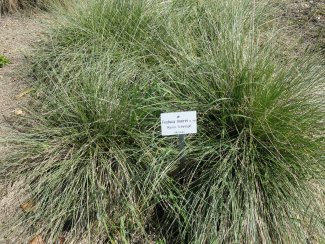Northern Africa: Algeria; Morocco
HABIT Perennial; caespitose; clumped densely. Butt sheaths persistent and investing base of culm; with compacted dead sheaths. Basal innovations intravaginal. Culms 50–100 cm long. Lateral branches lacking. Leaf-sheaths smooth; glabrous on surface. Ligule a ciliolate membrane; 2 mm long; lacerate; truncate. Leaf-blades conduplicate; 30–50 cm long; 3–5 mm wide. Leaf-blade midrib conspicuous. Leaf-blade venation with 7–9 secondary veins; without layer of subepidermal sclerenchyma masking vein striation. Leaf-blade surface scabrous; rough adaxially; glabrous. Leaf-blade margins scabrous. Leaf-blade apex attenuate. INFLORESCENCE Inflorescence a panicle. Panicle open; linear; 15–20 cm long. Primary panicle branches 1–2 -nate; bearing spikelets almost to the base. Panicle branches scabrous. Spikelets solitary. Fertile spikelets pedicelled. FERTILE SPIKELETS Spikelets comprising 4–5 fertile florets; with diminished florets at the apex. Spikelets elliptic; laterally compressed; 8 mm long; breaking up at maturity; disarticulating below each fertile floret. Rhachilla internodes 0.8 mm long; smooth. GLUMES Glumes persistent; similar; shorter than spikelet. Lower glume lanceolate; 4–4.5 mm long; 1 length of upper glume; hyaline; without keels; 1 -veined. Lower glume lateral veins absent. Lower glume surface asperulous; rough above. Lower glume apex acute. Upper glume lanceolate; 4–4.5 mm long; 0.7–0.8 length of adjacent fertile lemma; scarious; without keels; 3 -veined. Upper glume surface asperulous; rough at apex. Upper glume apex obtuse. FLORETS Fertile lemma lanceolate; 5.5–6 mm long; chartaceous; without keel; 5 -veined. Lemma surface asperulous. Lemma apex acute; muticous, or mucronate. Palea 2 -veined. Palea keels scabrous. Palea surface scaberulous. Apical sterile florets resembling fertile though underdeveloped. FLOWER Lodicules 2. Anthers 3; 3 mm long. Ovary glabrous. FRUIT Caryopsis with adherent pericarp; oblong; sulcate on hilar side. Hilum linear; 0.5 length of caryopsis.
It is cultivated as an ornamental grass, densely clumped.
From Greenlee & Associates: Native to the Atlas Mountains in North Africa, it is reported to grow in southern Europe as well. There are currently two distinct clones being offered by California nurseries and sadly few nurseries are aware of the origin of their stock and many have mixed inventory and are unaware of the two clones.
Our original plants came from famous plantsman Kurt Bluemel in Maryland. The clone came from the European nursery trade and flowers spikes were inconspicuous, slender and did not produce viable seed. Some 6-7 years ago, the plant was offered by the Jelitto Seed Company and plants from this seed strain are almost completely difference plants. The seedling strain has courser foliage that grows 2-3' high and as wide, but has noticeably showy flower spikes that grow 2.5-3' above the foliage. Plants are similar when young and hard to distinguish from each other until they flower. I have often blended the two clones in plantings, sometimes on purpose, others by serendipity not knowing I had two clones. The 'flowering form', as we refer to it, actually sets viable seed and naturalizes in irrigated settings. The flowering form will noticeably differ from the original clone so care should be taken to shop from nurseries that know where their stock comes from.
